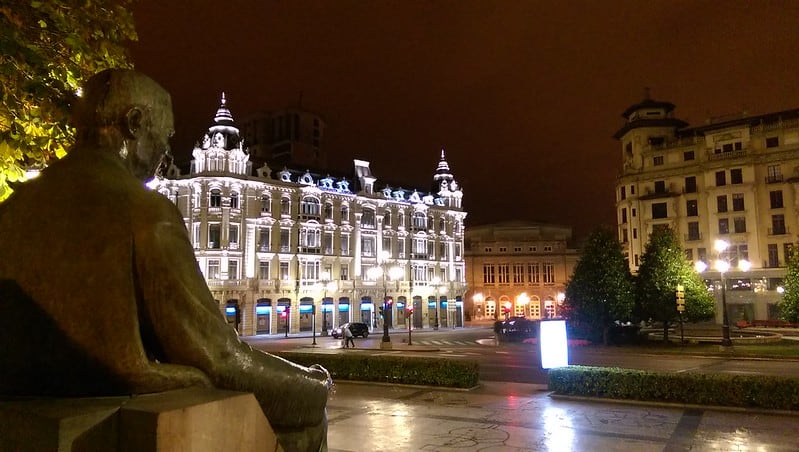Oviedo is the capital city of the Principality of Asturias in northern Spain. It is located in the center of Asturias, approximately 32 kilometers (20 miles) south of Gijón and 43 kilometers (27 miles) west of Avilés. Oviedo is the administrative, economic, and cultural center of the region, and is home to the University of Oviedo. It is situated at the confluence of the Nalón and Navia rivers, and has a population of approximately 225,000 people.
When visiting Asturias, make sure to include this northern Spanish city on your list of places to visit. This city is located in the northwest and is best known for its medieval old town and Gothic cathedral with its 9th-century Holy Chamber. While in the city, make sure to visit the Archaeological Museum of Asturias in the nearby convent. You can also visit the Fine Arts Museum, which includes two palaces and an extensive Spanish art collection.
Santa Maria del Naranco
The church of St Mary at Mount Naranco is one of the best examples of pre-Romanesque architecture in Asturias. It stands on the mountain of Mount Naranco, three kilometers from the town of Oviedo in northern Spain. The building’s interior is also worth a visit. A trip to Oviedo is not complete without a stop at this church.
The church is located on a hill overlooking Oviedo. It was originally part of a palace, and the building was decreed by King Ramiro I (843-850) of Asturias. Visitors can admire the beautiful views of the city and surrounding mountain ranges. A visit to Santa Maria del Naranco is a must for those who are in the area.
The church’s interior was recently restored, and it is one of the most beautiful buildings in Asturias. The church was once intended as a royal hall. King Ramiro I had it built in the outer regions of Asturias as his royal residence. The building was raised on a hill bearing the same name, and it was decorated in the Ramirense style, which is a form of pre-Romanesque architecture. The church was placed close to the nearby Church of San Miguel de Lillo, which had a Romanesque style.
Monte Naranco
If you are planning to go sightseeing in Oviedo, then you should visit the Montne Naranco. This hill offers incredible views of the city. The summit also has a recreation area and running track. The statue of Christ is particularly striking. The building is located on the same site as two national monuments. Here are some things to do in Monte Naranco. Listed below are some ideas to get around.
You can visit Monte Naranco, a 634 m tall, two thousand-foot-high mountain on the outskirts of Oviedo. The summit is home to a statue of The Sacred Heart of Jesus. There are also two pre-Romanesque style churches on the hill. Moovit is a free app that can help you get around town. It also lets you know the closest public transportation stations to Monte Naranco.
Museo de Bellas Artes de Asturias
The Museo de Bellas Arte, or “Museum of Fine Arts”, is located in Oviedo, Asturias, Spain. It is housed in three different buildings, including the Palacio de Velarde, the House of Oviedo-Portal, and the Sols-Carbajal. The museum features a large collection of medieval and contemporary artworks, ranging from the medieval to the contemporary.
The museum is located in three buildings, and has more than 10,000 works in its collection. Over 350-400 pieces are on display at any given time, and are divided among the Spanish and foreign artists. Works by Picasso and other contemporary artists are featured as well as classic paintings and sculptures by famous Spanish and Asturian artists. There are also collections of earthenware, glass objects, and photographs.
Visitors will be delighted by the diverse collection of international and Spanish art on display at the Museo de Bellas Arts in Oviedo. The museum is dedicated to preserving and promoting local culture, and is a wonderful place to spend a few hours with family and friends. A visit to the museum will surely bring back wonderful memories for all who visit it.
Campo de San Francisco
When you travel to Oviedo, you cannot miss visiting the iconic Campo de San Francisco. It is the largest urban park in Asturias and was once the site of the former Convent of San Francisco. Thousands of tourists visit the area each year, and it has a number of unique and memorable features. Here, you will find an array of monuments and streets. Explore them to discover some of the city’s best attractions.
The historic Convent of San Francisco owned a kitchen garden, which was transformed into a public park in the 19th century. The park is 90000 square metres of pristine greenery. The park features a Neoclassical sofa, statues, and a variety of flora. You can also stroll along the paved paths, which are lined with oak trees. Besides, there are plenty of benches that will give you a good rest.
The city is famous for its vibrant nightlife and tapas, but it is also worth visiting the historic centre of Oviedo, which includes the picturesque Campo de San Francisco. While in Oviedo, you can also take a stroll around the lush greenery at Campo de San Francisco. The park was once an orchard for Franciscan monks, but was turned into a public space in the 18th century. It has more than 120 different species of trees, including some rare plants. You can even get fit in the park with the help of its workout equipment.
Plaza del Fontan
Oviedo’s busy Plaza del Fontan is a lively square lined with cafes and restaurants. A 19th century market building dominates the square. You can enjoy a meal on the square’s many tables, or try your luck in one of the casino games. While you’re here, be sure to check out its impressive ornate architecture. If you’re interested in a little history, there’s plenty of that here, too.
The Fontan, which translates to spring, was formed after a small gap dried up in the town’s natural lagoon. The fountain became a recreational spot for the rich, but over time, the lagoon became unsanitary. In time, the fountain was abandoned and is now a market and entertainment venue. You can enjoy delicious local cuisine and try your hand at pouring cider like the waiters do.
The covered market is a popular place for tourists to visit. The El Fontan market, located in an old building, has been selling produce and meat since the 13th century. Visitors will enjoy watching the locals and purchasing souvenirs and snacks. While it’s best to arrive before 2pm, the market is packed with shoppers and tourists. Alternatively, you can browse the stalls and pick up something to eat while you’re here.
Catedral de San Salvador de Oviedo
The Catedral de San Salvador de Ovieso in northern Spain is a Roman Catholic minor basilica and the centrepiece of Oviedo. This beautiful cathedral dates back to the 14th century and is known for its striking Gothic-style architecture. In the center of town, the cathedral is one of the city’s most popular tourist attractions. The interior is equally impressive, with an array of colorful frescoes and paintings.
The cathedral’s tower is a romantic poem in stone. The tower was added to the cathedral during construction, but it was not completed until 1587. The tower is made up of five main pieces that taper upwards. The best view of the tower is from the plaza in front of the cathedral, where the statue of La Regenta is situated. Once you have admired the tower’s intricate details, you should visit the church’s plaza.
Inside the cathedral, you can find the magnifico coro and organs. The choir and altar are also well preserved. In addition, the cathedral is home to a neoclassical chapel. Visitors can also see a collection of medieval art. The church has been a place of worship for the people of Oviedo for over one hundred years. This cathedral is one of the most beautiful in Spain, and is worth the trip.
Teatro Campoamor
The Theater Campoamor in Oviedo is a landmark located on the grounds of the convent of Santa Clara. The theater was constructed in 1876 and the name Campoamor was suggested by writer Leopoldo Alas “Clarin” after a famous Navia politician and poet. The theater is now used to host various events, including opera and ballet.
Oviedo is a vibrant city with plenty to see and do. The Teatro Campoamor is the city’s main theater, which hosts the annual Prince of Asturias awards in October. The theater is an impressive 1892 structure, having been named after the well-known Spanish poet Ramon de Campoamor. Campoamor adhered to the Spanish realism movement and became famous during his lifetime. The theater was built to replace the old, creaky Fontan plaza. Its design reflects an Italian flair and was built with major Italian operas in mind.
The Teatro Campoamor is located in the heart of Oviedo and is considered a paradigm for cultural activity in the region. It has hosted some of Spain’s most famous musicians, including Rubinstein, Bartok, and Rostropovich. Victoria de los Angeles reopened the theater in 1948 and performed in it. Since then, many world-renowned musicians have performed there.
Archaeological Museum of Asturias
The Archaeological Museum of Asturia in Oviedo Spain contains collections ranging from prehistoric times to Roman era. This museum displays artifacts and exhibits from different periods, including the Bronze Age and the end of the Copper Age. The museum also displays Roman art, including coins, sculptures, and weapons. A visit to the museum will give you an overview of the region’s history.
The collection at the Archaeological Museum of Asturia is extensive, including an ape skeleton found in the second-floor exhibit. Other exhibits include a variety of pieces from the Paleolithic and Neolithic ages. The museum is open Wednesday through Friday from 9:30 a.m. to 8:00 p.m. and closed on Mondays and Tuesdays. On weekends, it is open until 3pm.
The Archaeological Museum of Asturias is housed in a restored 16th-century monastery. The museum features exhibitions on prehistoric cave art to medieval Asturias. There are several departments for visitors to explore, from Neolithic and Celtic to Roman eras and the medieval Kingdom of Asturias. There are also rare artifacts and ancient documents from the region’s history.

